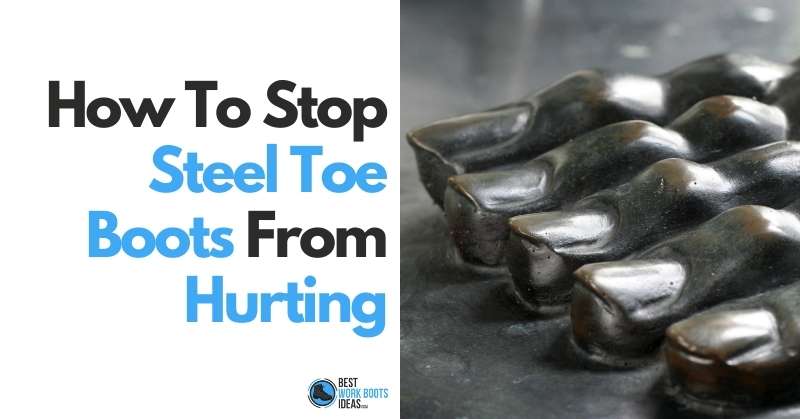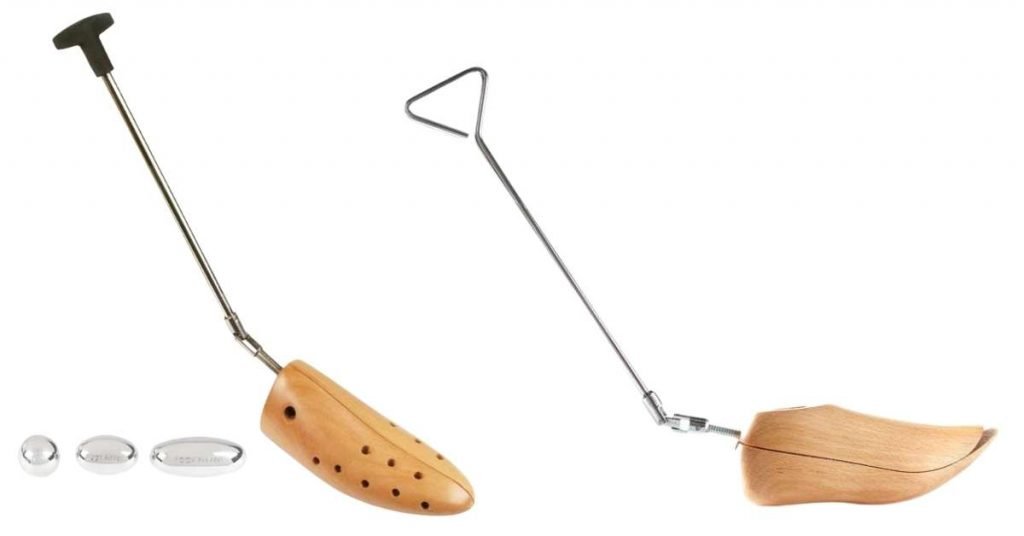How to Stop Steel Toe Boots From Hurting: Everything You Need to Know About the Secrets to Reducing Excruciating Foot Pain Growing by the Day, Hour, and Minute

Steel boots can be stretched and broken in to give your feet a more comfortable fit in a number of ways.
There are treatments and mechanical methods that can be used in combination to provide a better fit, as well as some awareness of your socks and foot size that will help as well.
There are many more reasons they could be hurting your feet, it’s not a short list.
In this article I intend to teach you everything there is to know about stopping your steel boots from hurting.
Contents
How to Stop Steel Toe Boots from Hurting Your Feet
- Condition them
- Stretch them
- Shrink them
- Adjust your lacing
- Get arch supports
- Change your socks
- Understand your sizing
- Buy a new pair of work boots
This is by no means an exhaustive list, but it’s a good place to start.
Furthermore, it will allow you to quickly diagnose your own situation and hopefully find a quick solution.
We have a couple articles on this topic, and I will link out to those articles as I proceed in this article.
Don’t worry, I’ll make it as easy and painless as possible for you.
Before You Try to Fix Anything, Consider THIS
Many people think that they have a properly sized footwear, but are simply unaware of how much room their feet and toes need.
It’s easy to walk into a shoe store and grab a pair in your size without trying a few pairs to see what your feet like.
It also might be the reason why your feet hurt.
Just because you think you know your shoe size doesn’t mean that number is accurate.
We wrote an article on how work boots should fit, so please do have a read of that.
You should have anywhere between ¼ and ¾ inches of room for your toes to move around at the front of the boot. I prefer to err on the side of caution and give myself extra room for my toes in work boots.
Your heel should feel some resistance as you’re putting the boot on, but as your toes reach the front your heel should slide into place.
There should be no more than ⅛ inch of slippage as you walk. Over time the boot will break in and you’ll have 0 inches of slippage.
The width of the boot should be enough so the sides of your feet should feel contact, but not pressure. This description also applies for the vamp and your instep.
Check out my earlier article if you’d like a thorough discussion of how steel boots should fit.
The last thing you want is your steel toe boots causing you foot problems.
Why Do Toes Need So Much Room in Work Boots?
If you were unaware, toes play a huge part in helping you with all movement and balance.
This is why even if it seems like there’s plenty of room for them in your boot, your toes might be hitting a literal wall when they try to do their job and help you stay on your feet.
Imagine flexing a muscle inside your foot that can’t fully activate because the toes can’t move where they’re trying to.
Can you imagine how this may impact your little toe inside a restricted toe box area?
Do that enough times, and you’re going to feel some serious pain all around your foot and probably elsewhere in your body too such as your back.
My work (carpentry and painting) often had me on A-frame and extension ladders, so I really wanted to make sure my toes were in the game.
It wasn’t an option for me to feel like my feet were trapped.
Besides being uncomfortable or painful, it had the potential for causing foot injuries.
Whether the boots are steel toe, alloy toe, or composite toe, your feet and toes need a certain amount of room to be happy and healthy.
Painful blisters are something you really want to avoid.
The thing about the human body is this: it doesn’t care what our beliefs are, it’s responding to its own set of rules.
1. Condition steel toe boots for greater comfort
The first action you should take is simply conditioning your boots so they’re more flexible and pliable.
It might not be that your boots don’t fit, just that they’re too darn stiff!
Conditioning the leather of the boots is a great place to start if you’re after greater comfort.
After grabbing some boot or leather conditioner in a local store or online, the next move is to clean your boots. Once you’ve got them cleaned up, dry them properly.
If you’re thinking you’re just gonna throw them in the dryer, that’s going to take you back to square one.
Now that your boots are washed and dried, apply the leather conditioner per the instructions on the bottle.
Let that absorb the amount of time suggested by the manufacturer and then try out your boots.
It might be that the conditioner gives them enough give so your feet stop hurting!
2. Get ‘em or stretch ‘em longer.
If conditioning alone doesn’t stop the pain, it’s time to stretch your boots! It’s best to start by washing, drying, and conditioning them so that the leather doesn’t rip or crack. Once that’s done, you’ll probably want to get a shoe stretcher to assist the process.

There are three main types of boot stretcher:
- For length
- For width
- For height
Picking the right one will require you to have a little understanding of where it is exactly that the boots are hurting you.
Is the boot not long enough?
Not wide enough?
Not tall enough?
Maybe a mixture of more than one of those?
Depending on your needs, grab the appropriate boot stretcher(s), and slowly but surely create the boot your foot really wants.
3. Shrink Your Boots to the Size Your Feet Need
Sometimes it can happen that your boots are actually too big and you’ll need to shrink them to fit.
This is an easy fix that just requires you to submerge the boots in lukewarm water until they’re saturated.
After that, empty ‘em out and put ‘em on.
This is the same method that’s often used to break in cowboy boots.
It’s important that you wear them until they dry, as your foot is acting as the mold for the boot.
If this is too uncomfortable for you, you can put a plastic bag over your foot prior to putting the boot on.
I can’t say it’ll keep you bone-dry, but it will certainly be drier.
Remember that you have to wear the type of sock you would normally wear with the boot.
Failing to do this will achieve nothing, nothing I say!
4. Lace lighter, not tighter
Sometimes our foot pain from steel toe boots comes from how aggressively we’re lacing them up each morning.
It might be an incredibly simple fix that just requires you to spend 10 or 15 minutes adjusting how tight the laces are at each pair of eyelets.
Don’t get annoyed, frustrated, or feel like you’re taking too long.
By making sure the laces and tongue are evenly distributing pressure, you’ll remove the pinch that could be causing you pain.
5. Arch supports for the win
Another quick fix for pain caused by steel toe boots can be arch supports.
As an extremely flat footed person, I’ve used arch supports for years, and can’t go without them.
This simple solution made a life-changing difference for me and many others.
I went from having sore feet to a pair of very comfortable work boots.
If you’re not sure of what you need, go see a podiatrist, or even the owner of an orthopedic shoe store.
Any orthopedic store owner will be able to tell you pretty quickly whether or not you’re a candidate for a pair of arch supports.
Make sure that if you’re doing this, you’re removing the existing footbed before inserting the new one.
6. Change your socks
Sometimes the socks you’re wearing can turn a perfectly sized pair of work boots into a painful nightmare.
People that wear work boots sometimes get in the habit of wearing overly thick tube socks to protect their feet from being in pain.
Ironically, it might actually be the cause of the pain.
7. Size matters…with boots
I’m going right back to where I started and telling you to double check that your sizing is correct.
Yes, the tips I’ve given you are helpful, but they’ll only take you so far.
It’s possible to stretch a boot, condition a boot, but not outright change a boots’ size from a 10 to 12!
It’s a hard pill to swallow that you might not know something crucial about your own life.
I had to accept that recently when a dentist told me my diet needed to change or I’d be looking at a mouth full of root canals.
I couldn’t believe this, I run miles each day, go to the gym, eat (what I thought was) an extremely well balanced diet, I brush/floss/mouthwash religiously… and a dentist is telling me what a child gets told by their parents.
How could this be???
All I went for was what I thought was a loose filling, and I got a drastically different experience.
What I said earlier, the body doesn’t care what our beliefs are, it’s got its own set of rules.
8. Maybe its time to Buy a Pair of Comfortable steel toed work boots
If some of the solutions above don’t help much then it might be time to search for a pair of comfortable steel toe work boots.
Have a read of the article linked above to give you some ideas of what to look for.
The Secret’s Out
I hope this has been helpful for you to discover what you can do about the pain you’re experiencing from your steel toe boots.
If you suffer from foot problems such as Plantar fasciitis, bunions or foot deformities then you should ideally speak to a Podiatrist who will help you with your individual needs.
Working or living in pain is no good, and anything we can do to avoid it is crucial.
Get out of pain and back to living your best life
